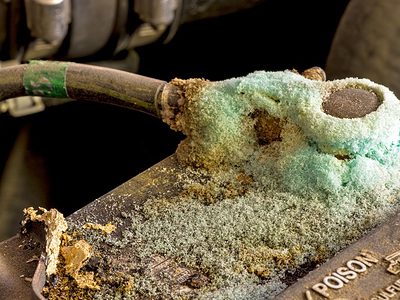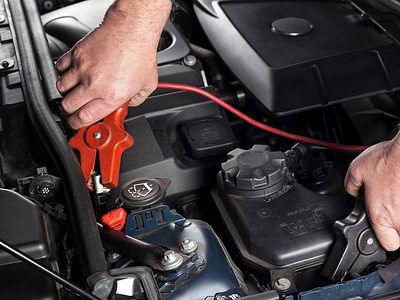
In the automotive world, very few questions are as rife yet controversial as this: “can a car battery shock you?” There are valid to say yes and no simultaneously, depending on the battery type, mode of contact, materials used to handle the battery, etc.
This article will focus on the regular 12V lead-acid battery, the most common cell in today’s cars. It’ll explain the risks involved with this kind of battery and give tips for handling most battery types you’ll come across.
Why Don’t Batteries Shock You?
In case the subheading wasn’t already clear, a 12V battery will not shock you, at least not under normal circumstances. But why?
The voltage is the main reason you can safely touch your car’s battery terminals and walk away unhurt. While most car batteries have enough amperage to fry you, the voltage (12V) is not enough to cause harm.
This makes sense if you think of the voltage as pressure. So, although your battery has enough current to cause you significant harm, the 12 volts don’t provide enough pressure to push any serious amount of that current through the contact resistance of your skin. However, you may feel tingling if you touch the battery terminals with wet hands—that’s certainly not the life-threatening electrical torture you imagined.
Does That Mean 12V Batteries Are Harmless?
Your car battery may not be able to send muscle-wrecking electric shocks through your body, but it can still jeopardize your existence if proper care is not taken.
Some of the biggest dangers associated with lead acid batteries are gassing and explosions. Gassing refers to a situation where the battery releases hydrogen sulfide (H2S) gas when overcharged. The gas is colorless, flammable, poisonous, and smells like rotten eggs. It also accumulates at the bottom of poorly ventilated spaces due to its higher density than air.
On the other hand, explosions may occur from the accumulation of hydrogen and oxygen gasses. Hydrogen is colorless, odorless, lighter than air, and highly flammable, while oxygen can escalate fires or explosions. These gasses are usually locked up within sealed lead acid batteries like AGMs. But even in unsealed models, you have nothing to worry about unless you’re charging the battery in a poorly ventilated and sealed room. Hydrogen gas may accumulate near the ceiling, creating a fire or explosion hazard.
Another danger you can’t turn a blind eye to when talking about car batteries is inadvertently bridging the battery terminals with a wrench or other metal equipment. Unlike your body, a metal wrench has little resistance to electricity, and the battery will take advantage of this to pump a lot of current through it. This will make the wrench extremely hot and may even weld it in place. In the worst-case scenario, the battery could explode, spraying sulphuric acid all over.
This continues until and unless the battery fails, which will eventually happen as the rapid flow of electrons drains it, or the circuit becomes disconnected somehow. It’s bad news.
Lithium-ion Batteries Are an Entirely Different Matter
At the heart of the modern automobile era is lithium-ion batteries powering hybrid and electric vehicles, alongside conventional lead-acid batteries for the starter, lighting, and other smaller functions. And unlike their lead-based counterparts, lithium-ion batteries run at far larger voltages.
While a single lithium-ion cell may boast 3–4V, they’re often connected in series and parallel to form battery packs. An electric car may require 400–800V, while 100V-200V may suffice for a hybrid. You definitely don’t want to mishandle this one or even come close to it unless you’re a certified expert on the technology. Of course, in practice, the high voltage battery packs of hybrid and electric vehicles are well hidden, so you’re unlikely to come in contact with them unless you go searching.
It’s also worth noting that lead acid batteries are not the same. You must have noticed that the only reason why the typical lead-acid battery won’t shock you is that it’s rated at only 12V. However, not all car batteries have such low voltages. In the early 2000s, a large movement called for a move to higher voltage systems. However, while the switch never really happened, there are some 24V and even 36V batteries. If your car uses one of them, it’s better to be safe than sorry, especially if you consider that 30V is generally considered to be a conservative threshold value for dangerous voltage.
What Are Some Tips for Working With Car Batteries?
It is important to show a high degree of caution when working with car batteries. Though you’re unlikely to be electrocuted under normal circumstances, mishandling batteries can be life-threatening. So, follow these tips when working with them:
- Wear gloves and other protective gear when performing any task involving car batteries. This should protect your hands from any acid leaks.
- Flush with excess water as soon as possible if you spill battery acid on your skin. Do the same and seek medical attention if the acid gets in your eyes.
- Do not overcharge your battery, as it could cause an explosion.
- Store car batteries in a cool, dry place. They’re capable of leaking acid if they get too hot.
Your Battery Won’t Shock You, but It’s Not Harmless
Can a car battery shock you? Now you know the answer is a no. However, while touching the terminals of your battery is not expected to electrocute you, an electric shock is not the only danger it poses. Be cautious when handling a battery during any inspection or change. And remember to always follow the manufacturer’s guidelines for battery care and handling, and direct any questions to a professional.
If you have a dead battery that needs replacing, follow our battery reconditioning guide to get a few more years out of it.
FAQs
Do You Need Gloves To Change a Car Battery?
For safety, it is essential to wear gloves (preferably rubber or latex) when handling your car battery. Most modern batteries are properly sealed and are therefore not expected to leak when you handle them. But it’s still important to wear proper protective gear in case of any eventualities. Besides, the car’s engine compartment could be filthy, making direct contact highly unpleasant.
At What Voltage Do You Feel a Shock?
Electricity must have a suitable voltage and current to cause a shock. If any of them is very low, the chances of getting shocked will be minimal. For example, you get shocked by touching a live wire for an outlet because the voltage is 120V or 240V (for most of Europe), and the current is usually around 15-20 amperes. This combination is sufficient to overcome your skin’s resistance, even more so when wet.
The most dangerous aspect of an electrical shock is the current (amperage) and not the voltage. A fixed current would not necessarily cause more harm at 1,000 than 100 volts. If anything, 100V is already enough to push the current through your skin and cause severe damage. However, a tiny change in amperage could make the difference between a slight sting or devastating pain. Contact duration also plays a significant role in the effect of an electric shock.
Take a look at the following chart from the U.S. Occupational Safety and Health Administration (OSHA):
<1 mA: Not perceptible
1–5 mA: Slight shock is felt; disturbing but not painful.
6–30 mA: Painful shocks; loss of muscle control.
50–150 mA: Extreme pain, severe muscle reactions, respiratory arrest, and possibly death.
1000–4300 mA: Heart stops pumping, nerve damages occur, and death is likely.
10,000mA: Cardiac arrest, severe burns, and death.
Why Do I Get Shocked Every Time I Get Out of My Car?
The shock you get when you get out of your car is due to the static current generated by friction between your clothes and the car’s seat fabric. The static electricity runs through you to earth whenever you alight from your car to the ground. This is a global phenomenon that is impossible to prevent.
You can minimize the effects of this shock by holding on to a metal part of your car as you go out. This will allow the static current to flow through the vehicle’s bodywork, preventing sudden discharge to the earth, which causes the shock in the first place.
How Do I Not Get Shocked When Changing a Car Battery?
While you’re unlikely to be shocked when changing a car battery, here are some general safety tips to follow:
-Turn off your car and remove your key from the ignition.
-Protect yourself appropriately with gloves and other safety materials.
-Disconnect the negative (black) terminal before the positive (red) terminal.
-Make sure your wrench is insulated if you’re using one.
-Remove the old battery only after the terminals are fully disconnected.
-Carefully place the new battery in position and reconnect the terminals.
















